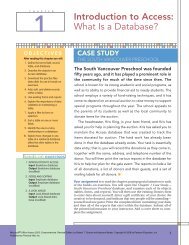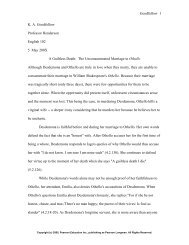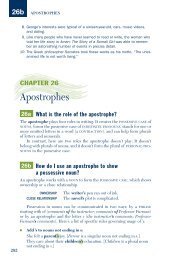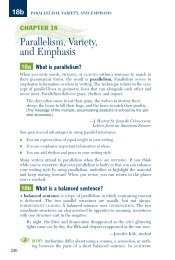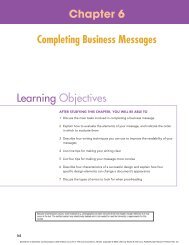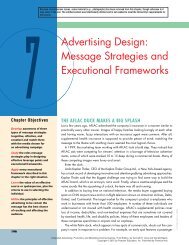Adapting Marketing to the New Economy - Pearson Learning Solutions
Adapting Marketing to the New Economy - Pearson Learning Solutions
Adapting Marketing to the New Economy - Pearson Learning Solutions
Create successful ePaper yourself
Turn your PDF publications into a flip-book with our unique Google optimized e-Paper software.
ISBN: 0-536-55105-7<br />
C H A P T E R 2<br />
<strong>Adapting</strong> <strong>Marketing</strong> <strong>to</strong><br />
<strong>the</strong> <strong>New</strong> <strong>Economy</strong><br />
In this chapter, we will address <strong>the</strong> following questions:<br />
1. What are <strong>the</strong> major forces driving <strong>the</strong> new economy?<br />
2. How are business and marketing practices changing as a result of <strong>the</strong> new economy?<br />
3. How has <strong>the</strong> Internet changed <strong>the</strong> way marketers use cus<strong>to</strong>mer databases and practice<br />
cus<strong>to</strong>mer relationship management?<br />
MARKETING MANAGEMENT AT NTT DOCOMO<br />
All over Japan, NTT (Nippon Telephone and Telegraph) DoCoMo makes money<br />
when mobile phones ring. Loosely translated, docomo means “everywhere”—an apt<br />
description of <strong>the</strong> service’s pervasive reach. More than 31 million cus<strong>to</strong>mers use <strong>the</strong><br />
DoCoMo phone service for Internet access as well as telephone calls. On <strong>the</strong> Web,<br />
<strong>the</strong>y can subscribe <strong>to</strong> <strong>the</strong> latest installment of a manga graphic s<strong>to</strong>ry, send and receive<br />
instant messages from friends and relatives, subscribe <strong>to</strong> wea<strong>the</strong>r reports, and even<br />
order goods. Ra<strong>the</strong>r than browse in a s<strong>to</strong>re, a cus<strong>to</strong>mer can use <strong>the</strong> phone’s compact<br />
Web viewing screen <strong>to</strong> look for a particular item (such as running shoes), choose a<br />
brand from among thousands listed, select a particular style and size, and place an<br />
order. Because <strong>the</strong> cus<strong>to</strong>mer’s address is already in <strong>the</strong> system’s memory, <strong>the</strong> order will<br />
be sent au<strong>to</strong>matically <strong>to</strong> a nearby 7-11 s<strong>to</strong>re for pickup or, for an extra fee, delivery.<br />
DoCoMo uses its technology and networks <strong>to</strong> track <strong>the</strong> goods and services<br />
accessed by each cus<strong>to</strong>mer and summarize all transactions in<strong>to</strong> a single monthly bill<br />
listing subscriber fees, usage fees, and all purchases. Content providers charge <strong>the</strong><br />
equivalent of a few dollars for monthly subscriptions; DoCoMo profits by collecting<br />
<strong>the</strong>se fees from cus<strong>to</strong>mers and subtracting a 9 percent commission before sending <strong>the</strong><br />
remainder <strong>to</strong> <strong>the</strong> providers. These commissions add up, given that <strong>the</strong> average mobile<br />
A Framework for <strong>Marketing</strong> Management, Second Edition, by Philip Kotler.<br />
Copyright © 2003 by <strong>Pearson</strong> Education, Inc. Published by Prentice Hall.<br />
23
24 Part I Understanding <strong>Marketing</strong> Management<br />
phone user in Japan spends about $63 per month, compared with $53 per month for<br />
<strong>the</strong> average user in <strong>the</strong> United States. Cus<strong>to</strong>mers can even pay <strong>the</strong>ir DoCoMo bills at<br />
<strong>the</strong> nearest 7-11 s<strong>to</strong>re. Based on DoCoMo’s huge popularity in Japan—and its enviable<br />
earnings record of $3 billion yearly—NTT has launched a similar system in<br />
Germany, <strong>the</strong> Ne<strong>the</strong>rlands, and Belgium. 1<br />
Today’s companies need fresh thinking about how <strong>to</strong> operate and compete in <strong>the</strong> new<br />
economy, a hybrid economy made up of old and new elements. NTT DoCoMo is<br />
quickly gaining experience in this hybrid economy by blending advanced technology <strong>to</strong><br />
provide superior service, cus<strong>to</strong>mer by cus<strong>to</strong>mer. Many standard marketing practices of<br />
<strong>the</strong> old economy, such as mass media advertising, sales promotion, and sales force calls,<br />
will continue <strong>to</strong> be important. However, now businesses also have <strong>to</strong> quickly anticipate<br />
and respond <strong>to</strong> emerging cus<strong>to</strong>mer needs and expectations driven, in part, by <strong>the</strong> Internet<br />
and o<strong>the</strong>r technologies—or risk having competi<strong>to</strong>rs satisfy those needs first.<br />
In this chapter, we will first describe <strong>the</strong> key drivers of <strong>the</strong> <strong>New</strong> <strong>Economy</strong> and<br />
examine how business and marketing practices are changing. 2 Then we will look at<br />
how companies are using <strong>the</strong> Internet, cus<strong>to</strong>mer databases and datamining, and cus<strong>to</strong>mer<br />
relationship management (CRM) <strong>to</strong> improve <strong>the</strong>ir marketing performance.<br />
THE MAJOR DRIVERS OF THE NEW ECONOMY<br />
Many forces play a major role in reshaping <strong>the</strong> world economy, among <strong>the</strong>m technology,<br />
globalization, and market deregulation. Here we will describe four specific drivers<br />
that underpin <strong>the</strong> new economy: (1) digitalization and connectivity; (2) disintermediation<br />
and reintermediation; (3) cus<strong>to</strong>mization and cus<strong>to</strong>merization; and<br />
(4) industry convergence.<br />
Digitalization and Connectivity<br />
Much of <strong>the</strong> world’s business is now carried over networks connecting people and<br />
companies. These networks are intranets when <strong>the</strong>y connect people within a company<br />
<strong>to</strong> one ano<strong>the</strong>r and <strong>to</strong> <strong>the</strong> company mainframe; extranets when <strong>the</strong>y connect a company<br />
with its suppliers and distribu<strong>to</strong>rs; and <strong>the</strong> Internet when <strong>the</strong>y connect users <strong>to</strong><br />
<strong>the</strong> worldwide “information reposi<strong>to</strong>ry.” Companies also interact with suppliers and<br />
cus<strong>to</strong>mers <strong>to</strong> buy and sell over <strong>the</strong> Internet.<br />
Global connectivity is being fur<strong>the</strong>r enhanced by wireless communication.<br />
Consumers and businesses in Europe and Japan are already deeply involved in<br />
m-commerce (m for mobile) using systems such as NTT DoCoMo; <strong>the</strong> U.S. market<br />
for m-commerce is much less developed.<br />
Disintermediation and Reintermediation<br />
The amazing success of early online dot-coms such as AOL, Amazon, eBay, Yahoo!<br />
and o<strong>the</strong>rs struck terror in <strong>the</strong> hearts of many established manufacturers and retailers.<br />
Compaq had its hands tied because it sold its computers through retailers, whereas<br />
Dell Computer, which sold directly <strong>to</strong> cus<strong>to</strong>mers, was able <strong>to</strong> grow faster by harnessing<br />
<strong>the</strong> Internet <strong>to</strong> sell online. Many established intermediaries—notably books<strong>to</strong>res,<br />
music s<strong>to</strong>res, travel agents, and s<strong>to</strong>ckbrokers—felt intense pressure as online competi-<br />
A Framework for <strong>Marketing</strong> Management, Second Edition, by Philip Kotler.<br />
Copyright © 2003 by <strong>Pearson</strong> Education, Inc. Published by Prentice Hall.<br />
ISBN: 0-536-55105-7
ISBN: 0-536-55105-7<br />
Chapter 2 <strong>Adapting</strong> <strong>Marketing</strong> <strong>to</strong> <strong>the</strong> <strong>New</strong> <strong>Economy</strong> 25<br />
<strong>to</strong>rs emerged. They feared, and rightly so, being disintermediated by <strong>the</strong> new e-tailers.<br />
Although some established middlemen lost <strong>the</strong>ir businesses, new Web-based middlemen<br />
such as Priceline.com sprang up <strong>to</strong> serve businesses and consumers, bringing<br />
reintermediation on a grand scale.<br />
Traditional “brick-only” firms—such as Compaq, Barnes & Noble, and Merrill<br />
Lynch—dragged <strong>the</strong>ir feet, hoping that <strong>the</strong> assault of online-only firms would falter<br />
or disappear. They finally created <strong>the</strong>ir own Internet sales channels, offering a careful<br />
blend of off-line and online operations <strong>to</strong> retain <strong>the</strong> loyalty of retailers, brokers, and<br />
agents. Ironically, some competi<strong>to</strong>rs with off-line and online channels became<br />
stronger than pure dot-coms because <strong>the</strong>y had a larger pool of resources and wellestablished<br />
brand names. Meanwhile, many Web-based businesses have had financial<br />
woes, downsized <strong>to</strong> cut costs, and eventually declared bankruptcy—even as o<strong>the</strong>r pure<br />
dot-coms continue <strong>to</strong> prosper.<br />
Cus<strong>to</strong>mization and Cus<strong>to</strong>merization<br />
Cus<strong>to</strong>mization means that <strong>the</strong> company is able <strong>to</strong> provide individually differentiated<br />
products, services, prices, and delivery channels for each cus<strong>to</strong>mer. By going online,<br />
companies enable consumers <strong>to</strong> become prosumers, self-producing consumers who can<br />
essentially design <strong>the</strong>ir own goods. Companies have also acquired <strong>the</strong> capacity <strong>to</strong><br />
interact individually with each cus<strong>to</strong>mer by personalizing messages, products, and services.<br />
The combination of operational cus<strong>to</strong>mization and marketing cus<strong>to</strong>mization<br />
has been called cus<strong>to</strong>merization. 3<br />
Cus<strong>to</strong>mization may be very difficult <strong>to</strong> implement for complex products such as<br />
au<strong>to</strong>mobiles, and it can raise costs beyond what cus<strong>to</strong>mers are willing <strong>to</strong> pay. Ano<strong>the</strong>r<br />
potential problem is that some cus<strong>to</strong>mers don’t know what <strong>the</strong>y want until <strong>the</strong>y see<br />
actual products, and companies do not want <strong>to</strong> allow cus<strong>to</strong>mers <strong>to</strong> cancel orders once<br />
production begins. In addition, cus<strong>to</strong>mized products may be hard <strong>to</strong> repair. On <strong>the</strong><br />
o<strong>the</strong>r hand, cus<strong>to</strong>mization has worked well for some products—lap<strong>to</strong>p computers and<br />
skincare products—and is an opportunity worth investigating.<br />
Industry Convergence<br />
Industry boundaries are blurring at an incredible rate. Pharmaceutical companies, at<br />
one time essentially chemical companies, are now adding biogenetic research capacities<br />
in order <strong>to</strong> formulate new drugs, new cosmetics (cosmoneuticals), and new foods<br />
(nutriceuticals). Film companies such as Kodak were also chemical companies but now<br />
are moving in<strong>to</strong> electronics <strong>to</strong> digitize <strong>the</strong>ir image-making capabilities. All <strong>the</strong>se companies<br />
are recognizing that many new opportunities lie at <strong>the</strong> intersection of two or<br />
more industries.<br />
HOW BUSINESS PRACTICES ARE CHANGING<br />
The changes in technology and economy are eliciting a new set of beliefs and practices<br />
on <strong>the</strong> part of business firms. Table 2.1 shows <strong>the</strong> major business beliefs in <strong>the</strong> old<br />
economy and how <strong>the</strong>se beliefs have shifted in <strong>the</strong> new economy.<br />
Today’s economy and most companies are a hybrid of <strong>the</strong> old and <strong>the</strong> new economy.<br />
Companies need <strong>to</strong> retain skills and competencies that have worked in <strong>the</strong> past, but<br />
<strong>the</strong>y also need <strong>to</strong> add new knowledge and competencies if <strong>the</strong>y hope <strong>to</strong> grow and prosper.<br />
A Framework for <strong>Marketing</strong> Management, Second Edition, by Philip Kotler.<br />
Copyright © 2003 by <strong>Pearson</strong> Education, Inc. Published by Prentice Hall.
26 Part I Understanding <strong>Marketing</strong> Management<br />
TABLE 2.1 Old <strong>Economy</strong> versus <strong>New</strong> <strong>Economy</strong><br />
Old <strong>Economy</strong> <strong>New</strong> <strong>Economy</strong><br />
Organize by product units Organize by cus<strong>to</strong>mer segments<br />
Focus on profitable transactions Focus on cus<strong>to</strong>mer lifetime value<br />
Look primarily at financial scorecard Look also at marketing scorecard<br />
Focus on shareholders Focus on stakeholders<br />
<strong>Marketing</strong> does <strong>the</strong> marketing Everyone does <strong>the</strong> marketing<br />
Build brands through advertising Build brands through performance<br />
Focus on cus<strong>to</strong>mer acquisition Focus on cus<strong>to</strong>mer retention<br />
No cus<strong>to</strong>mer satisfaction measurement Measure cus<strong>to</strong>mer satisfaction and retention rate<br />
Overpromise, underdeliver Underpromise, overdeliver<br />
Similarly, <strong>to</strong>day’s marketplace is made up of traditional consumers (who don’t buy<br />
online), cyberconsumers (who mostly buy online), and hybrid consumers (who do both). 4<br />
Most consumers are hybrid: <strong>the</strong>y shop in grocery s<strong>to</strong>res but occasionally order<br />
online from Peapod; <strong>the</strong>y buy books in Barnes & Noble books<strong>to</strong>res and sometimes<br />
order books from bn.com. Thus, most companies will need a presence both off-line<br />
and online <strong>to</strong> cater <strong>to</strong> <strong>the</strong>se hybrid consumers. Companies are already adjusting <strong>the</strong>ir<br />
marketing practices <strong>to</strong> meet <strong>the</strong>se new conditions. We will examine three marketing<br />
practices in which companies and <strong>the</strong>ir marketers are getting involved: e-business,<br />
Web sites, and cus<strong>to</strong>mer relationship management.<br />
HOW MARKETING PRACTICES<br />
ARE CHANGING: E-BUSINESS<br />
E-business describes <strong>the</strong> use of electronic means and platforms <strong>to</strong> conduct a company’s<br />
business. The Internet helps companies conduct business faster, more accurately,<br />
over a wider range of time and space, at less cost, and with <strong>the</strong> ability <strong>to</strong> cus<strong>to</strong>mize<br />
and personalize cus<strong>to</strong>mer offerings. Organizations have set up Web sites <strong>to</strong><br />
distribute information and promote goods and services. They use Intranets <strong>to</strong> facilitate<br />
internal communication among employees and Extranets <strong>to</strong> facilitate <strong>the</strong><br />
exchange of data, orders, and payments with suppliers and distribu<strong>to</strong>rs. Bill Gates of<br />
Microsoft claims that his company is almost entirely run electronically; hardly any<br />
paper flows because everything is on <strong>the</strong> computer screen. 5<br />
E-commerce is more specific than e-business; it means that in addition <strong>to</strong> providing<br />
information about <strong>the</strong> company’s his<strong>to</strong>ry, policies, products, and job opportunities,<br />
<strong>the</strong> Web site allows transactions or facilitates <strong>the</strong> online sale of products and services.<br />
In turn, e-commerce has given rise <strong>to</strong> e-purchasing and e-marketing. With<br />
e-purchasing, companies use <strong>the</strong> Internet <strong>to</strong> efficiently purchase goods, services, and<br />
information from online suppliers. E-marketing describes a company’s efforts <strong>to</strong><br />
inform, communicate, promote, and sell its products and services over <strong>the</strong> Internet.<br />
E-business and e-commerce take place mainly over four major Internet<br />
domains: B2C (business-<strong>to</strong>-consumer), B2B (business-<strong>to</strong>-business), C2C (consumer<strong>to</strong>-consumer),<br />
and C2B (consumer-<strong>to</strong>-business). In addition, e-businesses can take <strong>the</strong><br />
form of pure-click or brick-and-click companies.<br />
A Framework for <strong>Marketing</strong> Management, Second Edition, by Philip Kotler.<br />
Copyright © 2003 by <strong>Pearson</strong> Education, Inc. Published by Prentice Hall.<br />
ISBN: 0-536-55105-7
ISBN: 0-536-55105-7<br />
Internet Domains: B2C (Business-<strong>to</strong>-Consumer)<br />
Chapter 2 <strong>Adapting</strong> <strong>Marketing</strong> <strong>to</strong> <strong>the</strong> <strong>New</strong> <strong>Economy</strong> 27<br />
More than 100 million Americans go online <strong>to</strong> look for information, research a product<br />
or service before buying, find travel information, and find out about movies, books, and<br />
leisure activities. 6 The most frequent online consumer purchases (in terms of <strong>the</strong> percentage<br />
of online buyers saying <strong>the</strong>y have purchased in <strong>the</strong> category) have been books (58<br />
percent), music (50 percent), software (44 percent), air tickets (29 percent), PC peripherals<br />
(28 percent), clothing (26 percent), videos (24 percent), hotel reservations (20 percent),<br />
<strong>to</strong>ys (20 percent), flowers (17 percent), and consumer electronics (12 percent).<br />
The Internet is most useful for B2C products and services when <strong>the</strong> consumer<br />
seeks greater ordering convenience (e.g., books and music), lower cost (e.g., s<strong>to</strong>ck<br />
trading or news reading), or information about product features and prices (e.g., au<strong>to</strong>mobiles<br />
or computers). It is less useful for products that must be <strong>to</strong>uched or examined<br />
in advance, although consumers can and do order major appliances, computers, even<br />
flowers or wine without seeing or trying <strong>the</strong>se products in advance. With B2C, <strong>the</strong><br />
exchange process has become cus<strong>to</strong>mer-initiated and cus<strong>to</strong>mer-controlled; often marketers<br />
must wait until cus<strong>to</strong>mers invite <strong>the</strong>m <strong>to</strong> participate in <strong>the</strong> exchange. Even after<br />
marketers enter <strong>the</strong> exchange process, cus<strong>to</strong>mers insulate <strong>the</strong>mselves with <strong>the</strong> help of<br />
agents and intermediaries and define what information <strong>the</strong>y need, what offerings <strong>the</strong>y<br />
are interested in, and what prices <strong>the</strong>y are willing <strong>to</strong> pay.<br />
Internet Domains: B2B (Business-<strong>to</strong>-Business)<br />
More activity is conducted on B2B sites than on B2C sites. B2B sites are making markets<br />
more efficient and changing <strong>the</strong> supplier-cus<strong>to</strong>mer relationship in profound ways<br />
(see Figure 2.1). Major research firms estimate that B2B commerce is ten <strong>to</strong> fifteen<br />
times greater than B2C commerce. Business buyers often get better prices by using<br />
B2B auction sites, spot exchanges, online product catalogues, barter sites, and o<strong>the</strong>r<br />
online resources. Many major enterprises, including Ford, General Electric, and<br />
Merck, have invested millions in Web-based procurement systems. The result:<br />
Invoices that used <strong>to</strong> cost $100 <strong>to</strong> process now cost as little as $20. Companies are also<br />
forming online buying alliances <strong>to</strong> secure even deeper volume discounts from suppliers.<br />
GM, Ford, and DaimlerChrysler formed Covisint and believe <strong>the</strong>y can save as much<br />
as $1,200 a car by combining <strong>the</strong>ir purchases on this electronic marketplace.<br />
In addition, business buyers have access <strong>to</strong> more information from (1) supplier<br />
Web sites; (2) infomediaries, third parties that add value by aggregating information<br />
about alternatives; (3) market makers, third parties that create markets linking buyers<br />
and sellers; and (4) cus<strong>to</strong>mer communities, online groups in which cus<strong>to</strong>mers swap s<strong>to</strong>ries<br />
about suppliers’ products and services. 7 As a result, pricing is more transparent.<br />
Price pressure on undifferentiated products will increase, whereas buyers will gain a<br />
better picture of <strong>the</strong> true value of highly differentiated products. Suppliers of superior<br />
products will be able <strong>to</strong> offset price transparency with value transparency; suppliers of<br />
undifferentiated products will have <strong>to</strong> drive down costs <strong>to</strong> compete.<br />
Internet Domains: C2C (Consumer-<strong>to</strong>-Consumer)<br />
With C2C, consumers are increasingly creating online product information, not just<br />
consuming it. They join Internet interest groups and chat rooms <strong>to</strong> share information,<br />
so that “word of Web” is joining “word of mouth” as an important buying influence.<br />
A Framework for <strong>Marketing</strong> Management, Second Edition, by Philip Kotler.<br />
Copyright © 2003 by <strong>Pearson</strong> Education, Inc. Published by Prentice Hall.
28 Part I Understanding <strong>Marketing</strong> Management<br />
FIGURE 2.1 The Supplier-Cus<strong>to</strong>mer Relationship, Traditional versus <strong>New</strong> <strong>Economy</strong><br />
Executives<br />
<strong>Marketing</strong><br />
Systems<br />
Sales<br />
Finance<br />
Manufacturing<br />
Supplier<br />
TRADITIONAL STRUCTURE<br />
SALES BUYING<br />
(a)<br />
NEW ECONOMY STRUCTURE<br />
(b)<br />
Cus<strong>to</strong>mer<br />
Supplier Cus<strong>to</strong>mer<br />
Executives<br />
<strong>Marketing</strong><br />
Systems<br />
Sales<br />
Finance<br />
Manufacturing<br />
Executive<br />
Merchandising<br />
Systems<br />
Buyers<br />
Finance<br />
Warehousing<br />
Executive<br />
Merchandising<br />
Systems<br />
Buyers<br />
Finance<br />
Warehousing<br />
Information about good companies and products travels fast, and information about<br />
bad companies and products travels even faster. As noted in Chapter 1, eBay is a one<strong>to</strong>-one<br />
online trading community with millions of registered users, mainly consumers<br />
who want <strong>to</strong> ei<strong>the</strong>r buy or sell offerings in more than 1,000 categories.<br />
Internet Domains: C2B (Consumer-<strong>to</strong>-Business)<br />
Consumers are also finding it easier <strong>to</strong> communicate with companies on <strong>the</strong> Web.<br />
Companies invite prospects and cus<strong>to</strong>mers <strong>to</strong> e-mail questions, suggestions, and even<br />
complaints. Some sites even include a “call-me” but<strong>to</strong>n—when a cus<strong>to</strong>mer clicks it,<br />
his or her phone rings with a company representative ready <strong>to</strong> answer questions.<br />
Although many online merchants respond slowly <strong>to</strong> consumer inquiries, smart on-line<br />
marketers answer quickly and send out newsletters, special offers based on purchasing<br />
his<strong>to</strong>ries, reminders of service requirements or warranty renewals, or announcements<br />
of special events. Frustrated consumers have <strong>the</strong> option of using sites such as<br />
eComplaints and PlanetFeedback.com <strong>to</strong> communicate <strong>the</strong>ir dissatisfaction with businesses<br />
and products. 8<br />
A Framework for <strong>Marketing</strong> Management, Second Edition, by Philip Kotler.<br />
Copyright © 2003 by <strong>Pearson</strong> Education, Inc. Published by Prentice Hall.<br />
ISBN: 0-536-55105-7
ISBN: 0-536-55105-7<br />
Pure-Click versus Brick-and-Click Companies<br />
Chapter 2 <strong>Adapting</strong> <strong>Marketing</strong> <strong>to</strong> <strong>the</strong> <strong>New</strong> <strong>Economy</strong> 29<br />
Among e-businesses, we can distinguish between pure-click companies, those that<br />
launched a Web site without any previous existence as a firm, and brick-and-click companies,<br />
established companies that added an online site for information or e-commerce.<br />
Pure-Click Companies Pure-click companies can be search engines, Internet<br />
Service Providers, commerce sites, transaction sites, content sites, and enabler sites.<br />
Search engines and portals such as Yahoo! started as search engines and later added services<br />
such as news, wea<strong>the</strong>r, and s<strong>to</strong>refronts, hoping <strong>to</strong> become <strong>the</strong> user’s point of entry<br />
on <strong>the</strong> Internet. Internet Service Providers (ISPs) such as AOL provide Internet and email<br />
connections for a fee. Commerce sites such as Amazon.com sell books, music, and<br />
so on. Transaction sites such as eBay take a commission for transactions conducted on<br />
<strong>the</strong>ir sites. Content sites such as WSJ.com (operated by <strong>the</strong> Wall Street Journal) offer<br />
financial news and o<strong>the</strong>r information. Enabler sites provide <strong>the</strong> hardware and software<br />
that enable Internet communication and commerce.<br />
Pure-click firms have failed for a variety of reasons: Many rushed in<strong>to</strong> <strong>the</strong> market<br />
without proper research or planning; had poorly designed Web sites; or lacked<br />
adequate infrastructures for on-time shipping and cus<strong>to</strong>mer service. To acquire cus<strong>to</strong>mers,<br />
pure-clicks often spent lavishly on mass marketing and off-line advertising,<br />
relied on buzz instead of using target marketing, and focused mainly on cus<strong>to</strong>mer<br />
acquisition instead of building relationships <strong>to</strong> form a loyal base of frequent users.<br />
Finally, many pure-clicks failed <strong>to</strong> build a sound business model that would deliver<br />
eventual profits. Webvan, an online grocery retailer, overexpanded and opened au<strong>to</strong>mated<br />
warehouses that operated far below <strong>the</strong> break-even point. Unable <strong>to</strong> attract frequent<br />
users, <strong>the</strong> company filed for bankruptcy after operating less than three years.<br />
Still, many pure-click dot-coms are surviving and even prospering, and o<strong>the</strong>rs<br />
have fundamentally sound business plans even though <strong>the</strong>y are showing losses <strong>to</strong>day.<br />
The ISP Earthlink, for example, enjoys a monthly contribution margin of at least $9<br />
from each subscriber <strong>to</strong> its Internet and e-mail services. Subscribers become profitable<br />
for Earthlink after <strong>the</strong>ir fees cover <strong>the</strong> $100 average cost of acquiring a new cus<strong>to</strong>mer,<br />
which takes about 11 months.<br />
Brick-and-Click Companies Many established companies moved quickly <strong>to</strong> open<br />
Web sites describing <strong>the</strong>ir business but resisted adding e-commerce out of concern<br />
that <strong>the</strong>y would be seen as competing with <strong>the</strong>ir off-line retailers and agents. For<br />
example, Merrill Lynch hesitated <strong>to</strong> introduce online s<strong>to</strong>ck trading <strong>to</strong> compete with<br />
E*TRADE, Schwab, and o<strong>the</strong>r online brokerages, fearing that its own brokers would<br />
rebel. Even <strong>the</strong> s<strong>to</strong>re-based bookseller Barnes & Noble delayed opening an online site<br />
<strong>to</strong> challenge Amazon.com because it was concerned about <strong>the</strong> effect on s<strong>to</strong>re sales.<br />
Liberty Mutual solved this problem by asking its online cus<strong>to</strong>mers <strong>to</strong> indicate<br />
whe<strong>the</strong>r <strong>the</strong>y prefer <strong>to</strong> buy directly or through a financial advisor. When cus<strong>to</strong>mers<br />
choose <strong>the</strong> advisor, Liberty Mutual relays information about <strong>the</strong>ir needs <strong>to</strong> an advisor<br />
for personal follow-up. As ano<strong>the</strong>r example, Avon conducted research and found little<br />
overlap between existing cus<strong>to</strong>mers and potential online cus<strong>to</strong>mers, so <strong>the</strong> company<br />
initiated e-commerce, and offered <strong>to</strong> help its reps set up <strong>the</strong>ir own Web sites, as well. 9<br />
Although brick-and-click firms face channel conflict issues, many are likely <strong>to</strong><br />
have more success online than pure-click competi<strong>to</strong>rs. First, companies such as<br />
Merrill Lynch and Wal-Mart have better known brand names; <strong>the</strong>ir cost of acquiring<br />
A Framework for <strong>Marketing</strong> Management, Second Edition, by Philip Kotler.<br />
Copyright © 2003 by <strong>Pearson</strong> Education, Inc. Published by Prentice Hall.
30 Part I Understanding <strong>Marketing</strong> Management<br />
a new cus<strong>to</strong>mer is $12 compared <strong>to</strong> <strong>the</strong> $82 that pure click e-tailers spend <strong>to</strong> acquire a<br />
new cus<strong>to</strong>mer. 10 Second, <strong>the</strong>y have greater financial resources and access <strong>to</strong> funds.<br />
Third, <strong>the</strong>y have deeper industry knowledge and experience, good supplier relationships,<br />
and a large cus<strong>to</strong>mer base. Fourth, <strong>the</strong>y can be reached 24 hours a day, 7 days a<br />
week, and <strong>the</strong> retailers accept merchandise returns in <strong>the</strong>ir s<strong>to</strong>res. And fifth, <strong>the</strong><br />
Internet allows <strong>the</strong>m <strong>to</strong> serve many cus<strong>to</strong>mers far from <strong>the</strong>ir s<strong>to</strong>re locations.<br />
HOW MARKETING PRACTICES ARE CHANGING:<br />
SETTING UP WEB SITES<br />
Clearly all companies need <strong>to</strong> move in<strong>to</strong> e-marketing and e-purchasing. In deciding <strong>to</strong><br />
operate a Web site, companies must answer many questions about attracting and<br />
retaining visi<strong>to</strong>rs, advertising online, dealing with channel partners, putting <strong>the</strong> site<br />
<strong>to</strong>ge<strong>the</strong>r, and making it profitable. Many of <strong>the</strong>se questions will be addressed throughout<br />
<strong>the</strong> book. Here we address only three: designing a Web site; promoting online;<br />
and building a revenue and profit model.<br />
Designing an Attractive Web Site<br />
A key challenge is <strong>to</strong> design a site that is attractive on first viewing, interesting enough<br />
<strong>to</strong> encourage repeat visits, and achieves <strong>the</strong> company’s objectives. Early text-based Web<br />
sites have increasingly been replaced by sophisticated sites that provide text, sound, and<br />
animation (see www.gap.com or www.1800flowers.com). Rayport and Jaworski have<br />
proposed that effective sites feature specific design elements that <strong>the</strong>y call <strong>the</strong> 7Cs: 11<br />
■ Context. Layout and design.<br />
■ Content. Text, pictures, sound, and video on <strong>the</strong> site.<br />
■ Community. How <strong>the</strong> site enables user-<strong>to</strong>-user communication.<br />
■ Cus<strong>to</strong>mization. Site’s ability <strong>to</strong> tailor itself <strong>to</strong> different users or <strong>to</strong> allow users <strong>to</strong> personalize<br />
<strong>the</strong> site.<br />
■ Communication. How <strong>the</strong> site enables site-<strong>to</strong>-user, user-<strong>to</strong>-site, or two-way communication.<br />
■ Connection. Degree <strong>to</strong> which <strong>the</strong> site is linked <strong>to</strong> o<strong>the</strong>r sites.<br />
■ Commerce. Site’s capabilities <strong>to</strong> enable commercial transactions.<br />
Designing an attractive Web site is an important skill for marketers. Even marketers<br />
who outsource this task should be knowledgeable about good site design principles<br />
(see “<strong>Marketing</strong> Skills: Web Site Design”). Once a site is built, <strong>to</strong> encourage repeat<br />
visits, <strong>the</strong> company needs <strong>to</strong> pay particular attention <strong>to</strong> context and content fac<strong>to</strong>rs.<br />
Context Fac<strong>to</strong>rs Visi<strong>to</strong>rs judge a site’s performance on its ease of use and its physical<br />
attractiveness. Ease of use covers three key attributes: whe<strong>the</strong>r <strong>the</strong> site loads<br />
quickly; whe<strong>the</strong>r <strong>the</strong> home page is easy <strong>to</strong> understand; and whe<strong>the</strong>r <strong>the</strong> visi<strong>to</strong>r can easily<br />
navigate <strong>to</strong> o<strong>the</strong>r pages that open quickly. The site’s physical attractiveness is determined<br />
by <strong>the</strong> following fac<strong>to</strong>rs: (1) <strong>the</strong> individual pages look clean and not overly<br />
crammed with content; (2) <strong>the</strong> type faces and font sizes are very readable; and (3) <strong>the</strong><br />
site makes good use of color and sound.<br />
Content Fac<strong>to</strong>rs Context fac<strong>to</strong>rs facilitate repeat visits, but <strong>the</strong>y do not ensure that<br />
this happens. Content that is interesting, useful, and continuously changing will draw<br />
A Framework for <strong>Marketing</strong> Management, Second Edition, by Philip Kotler.<br />
Copyright © 2003 by <strong>Pearson</strong> Education, Inc. Published by Prentice Hall.<br />
ISBN: 0-536-55105-7
ISBN: 0-536-55105-7<br />
MARKETING SKILLS: WEB SITE DESIGN<br />
Chapter 2 <strong>Adapting</strong> <strong>Marketing</strong> <strong>to</strong> <strong>the</strong> <strong>New</strong> <strong>Economy</strong> 31<br />
What if a Web site opened—and nobody visited? Considering <strong>the</strong> time, money,<br />
and effort companies must invest in a Web site, marketers must be familiar with<br />
<strong>the</strong> fundamentals of design, starting with an understanding of how Internet<br />
surfers behave. On <strong>the</strong> Web, visi<strong>to</strong>rs control what <strong>the</strong>y see and for how long—<br />
and many are impatient. Therefore, designers should keep things simple, choosing<br />
graphics that will load quickly and grab attention. In addition, <strong>the</strong>y need <strong>to</strong><br />
show what <strong>the</strong> site will do for users through an informative home page, clearly<br />
labeled links, and search capabilities. Because reading words on a screen is not as<br />
easy as reading words in print, a well-designed site will use headlines, bullet<br />
points, and short bursts of text <strong>to</strong> convey key ideas. In addition, designers must<br />
think about how visi<strong>to</strong>rs are likely <strong>to</strong> move through <strong>the</strong> site and prominently<br />
position links so visi<strong>to</strong>rs can easily find different types of information.<br />
When a company wants <strong>to</strong> reach a global audience, <strong>the</strong> Web site should<br />
accommodate different languages, cus<strong>to</strong>ms, and content. Ano<strong>the</strong>r important task<br />
is <strong>to</strong> plan out a logical navigation path for visi<strong>to</strong>rs by coordinating <strong>the</strong> graphics,<br />
words, and links. Remember that some visi<strong>to</strong>rs may click past introduc<strong>to</strong>ry pages<br />
<strong>to</strong> view specific details. As a result, a good site design will help visi<strong>to</strong>rs determine<br />
where <strong>the</strong>y are on <strong>the</strong> site, what else is available, and how <strong>the</strong>y can get <strong>to</strong> <strong>the</strong><br />
exact information <strong>the</strong>y want. Finally, Web designers should test and retest <strong>to</strong> be<br />
sure prospective visi<strong>to</strong>rs will not get lost or frustrated in accessing <strong>the</strong> site—and<br />
<strong>to</strong> determine whe<strong>the</strong>r <strong>the</strong> site is set up <strong>to</strong> accomplish its purpose.<br />
Web design is a valued skill at Yahoo! This well-trafficked portal looks<br />
exciting, organizes links so visi<strong>to</strong>rs can find what <strong>the</strong>y need, and even allows visi<strong>to</strong>rs<br />
<strong>to</strong> cus<strong>to</strong>mize <strong>the</strong> site <strong>to</strong> <strong>the</strong>ir personal specifications. The company carefully<br />
localizes <strong>the</strong> site’s content and functionality for each country. As one example,<br />
U.S. users sort names in online address books alphabetically. However, users in<br />
some Asian nations sort names according <strong>to</strong> <strong>the</strong> number of strokes in each character.<br />
Incorporating <strong>the</strong>se nuances in<strong>to</strong> <strong>the</strong> design of local Yahoo! sites helps <strong>the</strong><br />
company appeal <strong>to</strong> its target audiences and encourage long-term loyalty. 12<br />
repeat visits. Certain types of content are effective in attracting first-time visi<strong>to</strong>rs and<br />
bringing <strong>the</strong>m back again: (1) deep information with links <strong>to</strong> related sites, (2) changing<br />
news of interest, (3) changing free offers, (4) contests and sweepstakes, (5) humor<br />
and jokes, and (6) games.<br />
Getting Feedback From time <strong>to</strong> time, a company needs <strong>to</strong> reassess its site’s attractiveness<br />
and usefulness. One way <strong>to</strong> do this is <strong>to</strong> ask site design experts. But <strong>the</strong> more important<br />
source of feedback is users, who can explain what <strong>the</strong>y like and dislike about <strong>the</strong> site<br />
and offer suggestions for improvement. Hallmark, General Electric, and o<strong>the</strong>r firms have<br />
users test and critique company sites, <strong>the</strong>n retest over time as <strong>the</strong> sites change. 13<br />
Placing Ads and Promotion Online<br />
Although Internet users generally do not welcome advertising, advertising does<br />
appear on <strong>the</strong> Internet. A company has <strong>to</strong> decide which forms will be most costeffective<br />
in achieving specific advertising objectives.<br />
A Framework for <strong>Marketing</strong> Management, Second Edition, by Philip Kotler.<br />
Copyright © 2003 by <strong>Pearson</strong> Education, Inc. Published by Prentice Hall.
32 Part I Understanding <strong>Marketing</strong> Management<br />
Banner ads, small boxes containing text and perhaps a picture, are <strong>the</strong> most<br />
extensively used Internet advertising <strong>to</strong>ols. Companies placing banner ads on relevant<br />
Web sites generally pay according <strong>to</strong> <strong>the</strong> size of <strong>the</strong> audience reached. Sometimes<br />
companies barter for banner placement ra<strong>the</strong>r than paying. Response is not very large:<br />
viewers are clicking on less than 1/2 of 1 percent of banner ads. Companies placing<br />
banner ads should ideally arrange <strong>to</strong> pay only when sales actually result from <strong>the</strong> clickthroughs<br />
on <strong>the</strong>se ads.<br />
Many companies gain online exposure by sponsoring special content on Web<br />
sites that carry news, financial information, and so on. Sponsorships are best placed in<br />
well-targeted sites offering information or services related <strong>to</strong> <strong>the</strong> company and its cus<strong>to</strong>mer<br />
base. The sponsor pays for posting <strong>the</strong> content and is publicly acknowledged as<br />
<strong>the</strong> sponsor of that page or site.<br />
A microsite is a limited area on <strong>the</strong> Web managed and paid for by an external<br />
advertiser. Microsites are particularly relevant for companies selling low-interest<br />
products such as insurance. For example, an insurance company can create a microsite<br />
within a used-car site, offering advice for buyers of used cars and at <strong>the</strong> same time<br />
offering a good insurance deal.<br />
Interstitials are advertisements that ‘pop-up’ between changes on a Web site. Ads<br />
for Johnson & Johnson’s Tylenol headache reliever pop up on brokers’ Web sites whenever<br />
<strong>the</strong> s<strong>to</strong>ck market falls by 100 points or more. Browser ads pay viewers <strong>to</strong> watch.<br />
Companies can also set up alliances and affiliate (or associate) programs. When one<br />
Internet company works with ano<strong>the</strong>r, <strong>the</strong>y end up “advertising” each o<strong>the</strong>r. Amazon<br />
has more than 500,000 associates that post Amazon banners on <strong>the</strong>ir Web sites.<br />
Companies can also undertake guerrilla marketing actions for publicity and <strong>to</strong><br />
generate word-of-mouth. When Yahoo! started its Denmark site, it distributed apples<br />
in <strong>the</strong> country’s busiest train station with <strong>the</strong> message that a trip <strong>to</strong> <strong>New</strong> York was<br />
being given away on <strong>the</strong> Yahoo! site within a few hours; it also got publicity in Danish<br />
newspapers.<br />
Building a Revenue and Profit Model<br />
Dot-com companies need a viable revenue and profit model, a business model that<br />
specifies <strong>the</strong> main revenue sources, and <strong>the</strong> projected revenue, costs, and income <strong>the</strong><br />
firm expects <strong>to</strong> achieve. Revenues may come from several sources:<br />
■ Advertising income. Sales of banner ads are one source of revenue.<br />
■ Sponsorship income. A dot-com can solicit sponsors for some of its content and collect<br />
sponsor fees.<br />
■ Alliance income. A company can invite business partners <strong>to</strong> share costs in setting up<br />
<strong>the</strong> Web site in exchange for free advertising.<br />
■ Membership and subscription income. Some Web sites charge a subscription fee <strong>to</strong><br />
use <strong>the</strong> site. The Wall Street Journal site successfully collects subscription fees for<br />
accessing its online edition; <strong>Economy</strong>.com, a research firm, broke even only a few<br />
weeks after it started charging corporate subscribers $17 per month. 14<br />
■ Profile income. Sites that have accumulated <strong>the</strong> profiles of a particular target group<br />
may be able <strong>to</strong> sell <strong>the</strong>se profiles if <strong>the</strong>y get permission. At <strong>the</strong> same time, <strong>the</strong>re is a<br />
code of ethics that warns against <strong>the</strong> wrongful sale or misuse of cus<strong>to</strong>mer information,<br />
and legal moves may soon limit this option.<br />
A Framework for <strong>Marketing</strong> Management, Second Edition, by Philip Kotler.<br />
Copyright © 2003 by <strong>Pearson</strong> Education, Inc. Published by Prentice Hall.<br />
ISBN: 0-536-55105-7
ISBN: 0-536-55105-7<br />
Chapter 2 <strong>Adapting</strong> <strong>Marketing</strong> <strong>to</strong> <strong>the</strong> <strong>New</strong> <strong>Economy</strong> 33<br />
■ Product and service sales income. E-commerce sites draw a good portion of <strong>the</strong>ir<br />
revenue from marking up <strong>the</strong> prices of <strong>the</strong>ir goods and services.<br />
■ Transaction commissions and fees. Dot-coms can charge commission fees on transactions<br />
between o<strong>the</strong>r parties. For example, eBay puts buyers in <strong>to</strong>uch with sellers and<br />
takes a commission of up <strong>to</strong> 5 percent on each transaction.<br />
■ Market research/information. Companies can charge for special market information<br />
or intelligence. <strong>New</strong>sLibrary charges a dollar or two <strong>to</strong> download copies of archived<br />
news s<strong>to</strong>ries. LifeQuote provides price comparisons from different life insurance<br />
companies and gets a commission of 50 percent of <strong>the</strong> first year’s premium from <strong>the</strong><br />
company chosen by <strong>the</strong> consumer.<br />
■ Referral income. Companies can collect revenue by referring cus<strong>to</strong>mers <strong>to</strong> o<strong>the</strong>r<br />
sites. Edmund’s receives a “finder’s fee” every time a cus<strong>to</strong>mer fills out an Au<strong>to</strong>-By-<br />
Tel form at Edmund’s site, regardless of whe<strong>the</strong>r a deal is consummated.<br />
How many dot-coms are profitable <strong>to</strong>day? McKinsey & Company studied more<br />
than 200 B2C e-businesses and found that 20 percent were making an operating<br />
profit. The best performers were transaction sites, with media and content sites lagging<br />
behind. 15<br />
HOW MARKETING PRACTICES ARE CHANGING:<br />
CUSTOMER RELATIONSHIP MARKETING<br />
In addition <strong>to</strong> e-marketing, companies are becoming more skillful in cus<strong>to</strong>mer relationship<br />
marketing and database marketing. Cus<strong>to</strong>mer relationship marketing<br />
(CRM) enables companies <strong>to</strong> provide excellent real time cus<strong>to</strong>mer service by developing<br />
a relationship with each valued cus<strong>to</strong>mer through <strong>the</strong> effective use of individual<br />
account information. Based on what <strong>the</strong>y know about each cus<strong>to</strong>mer, companies can<br />
cus<strong>to</strong>mize market offerings, services, programs, messages, and media.<br />
Cus<strong>to</strong>mer relationship marketing holds that a major driver of company profitability<br />
is <strong>the</strong> aggregate value of <strong>the</strong> company’s cus<strong>to</strong>mer base. 16 Winning companies<br />
are more productive in acquiring, keeping, and growing cus<strong>to</strong>mers. These companies<br />
improve <strong>the</strong> value of <strong>the</strong>ir cus<strong>to</strong>mer base by excelling at reducing cus<strong>to</strong>mer defection<br />
rates; increasing <strong>the</strong> life of each cus<strong>to</strong>mer relationship; enhancing cus<strong>to</strong>mer sales and<br />
profit potential; making low-profit cus<strong>to</strong>mers more profitable—or terminating <strong>the</strong>m;<br />
and focusing on high value cus<strong>to</strong>mers. As Table 2.2 shows, marketing <strong>to</strong> individual<br />
consumers is not <strong>the</strong> same as marketing <strong>to</strong> <strong>the</strong> masses.<br />
Peppers and Rogers suggest a four-step framework for one-<strong>to</strong>-one marketing: 17<br />
■ Identify your prospects and cus<strong>to</strong>mers. Do not go after everyone.<br />
■ Differentiate cus<strong>to</strong>mers in terms of <strong>the</strong>ir needs and <strong>the</strong>ir value <strong>to</strong> your company,<br />
<strong>the</strong>n lavish more effort on <strong>the</strong> most valuable cus<strong>to</strong>mers (estimate cus<strong>to</strong>mer value by<br />
<strong>the</strong> net present value of all future profits coming from purchases, margin levels, and<br />
referrals, less cus<strong>to</strong>mer-specific servicing costs).<br />
■ Interact with individual cus<strong>to</strong>mers <strong>to</strong> learn more about <strong>the</strong>ir individual needs and <strong>to</strong><br />
build stronger relationships.<br />
■ Cus<strong>to</strong>mize products, services, and messages <strong>to</strong> each cus<strong>to</strong>mer.<br />
A Framework for <strong>Marketing</strong> Management, Second Edition, by Philip Kotler.<br />
Copyright © 2003 by <strong>Pearson</strong> Education, Inc. Published by Prentice Hall.
34 Part I Understanding <strong>Marketing</strong> Management<br />
TABLE 2.2 Mass <strong>Marketing</strong> versus One-<strong>to</strong>-One <strong>Marketing</strong><br />
Mass <strong>Marketing</strong> One-<strong>to</strong>-One <strong>Marketing</strong><br />
Average cus<strong>to</strong>mer Individual cus<strong>to</strong>mer<br />
Cus<strong>to</strong>mer anonymity Cus<strong>to</strong>mer profile<br />
Standard product Cus<strong>to</strong>mized market offering<br />
Mass production Cus<strong>to</strong>mized production<br />
Mass distribution Individualized distribution<br />
Mass advertising Individualized message<br />
Mass promotion Individualized incentives<br />
One-way message Two-way messages<br />
Economies of scale Economies of scope<br />
Share of market Share of cus<strong>to</strong>mer<br />
All cus<strong>to</strong>mers Profitable cus<strong>to</strong>mers<br />
Cus<strong>to</strong>mer attraction Cus<strong>to</strong>mer retention<br />
Source: Adapted from Don Peppers and Martha Rogers, The One-<strong>to</strong>-One Future (<strong>New</strong> York:<br />
Doubleday/Currency, 1993). See <strong>the</strong>ir Web site www.1<strong>to</strong>1.com.<br />
Cus<strong>to</strong>mer Databases and Database <strong>Marketing</strong><br />
Successful companies know <strong>the</strong>ir cus<strong>to</strong>mers: They collect information, and s<strong>to</strong>re it in<br />
a cus<strong>to</strong>mer database, and apply database marketing. A cus<strong>to</strong>mer database is an organized<br />
collection of comprehensive information about individual cus<strong>to</strong>mers or<br />
prospects that is current, accessible, and actionable for such marketing purposes as<br />
lead generation, lead qualification, sale of a product or service, or maintenance of cus<strong>to</strong>mer<br />
relationships. Database marketing is <strong>the</strong> process of building, maintaining, and<br />
using cus<strong>to</strong>mer databases and o<strong>the</strong>r databases (products, suppliers, resellers) for <strong>the</strong><br />
purpose of contacting, transacting, and building relationships.<br />
A cus<strong>to</strong>mer database contains much more information than a cus<strong>to</strong>mer mailing<br />
list, which is simply a set of names, addresses, and telephone numbers. Ideally, a cus<strong>to</strong>mer<br />
database would contain <strong>the</strong> consumer’s past purchases, demographics (age,<br />
income, family members, birthdays), psychographics (activities, interests, and opinions),<br />
mediagraphics (preferred media), and o<strong>the</strong>r useful information. A business<br />
database should contain past purchases of business cus<strong>to</strong>mers; past volumes, prices,<br />
and profits; buyer team member names (and <strong>the</strong>ir ages, birthdays, hobbies, and favorite<br />
foods); status of current contracts; an estimate of <strong>the</strong> supplier’s share of <strong>the</strong> cus<strong>to</strong>mer’s<br />
business; competitive suppliers; assessment of competitive strengths and weaknesses in<br />
selling and servicing <strong>the</strong> account; and buying practices, patterns, and policies.<br />
Data Warehouses and Datamining<br />
Savvy companies capture information every time a cus<strong>to</strong>mer comes in<strong>to</strong> contact with<br />
any of its departments by making a purchase, requesting a service call, sending an<br />
online query, or returning a mail-in rebate card. They s<strong>to</strong>re this information in a data<br />
warehouse and analyze it <strong>to</strong> draw inferences about each individual cus<strong>to</strong>mer’s needs<br />
and responses. This allows <strong>the</strong> company’s cus<strong>to</strong>mer service reps or telemarketers <strong>to</strong><br />
respond knowledgeably <strong>to</strong> cus<strong>to</strong>mer inquiries based on a <strong>to</strong>tal picture of <strong>the</strong> cus<strong>to</strong>mer<br />
A Framework for <strong>Marketing</strong> Management, Second Edition, by Philip Kotler.<br />
Copyright © 2003 by <strong>Pearson</strong> Education, Inc. Published by Prentice Hall.<br />
ISBN: 0-536-55105-7
ISBN: 0-536-55105-7<br />
Chapter 2 <strong>Adapting</strong> <strong>Marketing</strong> <strong>to</strong> <strong>the</strong> <strong>New</strong> <strong>Economy</strong> 35<br />
relationship. Through datamining, marketing statisticians can extract useful information<br />
about individuals, trends, and segments from a massive data warehouse.<br />
Datamining involves <strong>the</strong> use of sophisticated statistical and ma<strong>the</strong>matical techniques<br />
such as cluster analysis, au<strong>to</strong>matic interaction detection, predictive modeling, and<br />
neural networking.<br />
In general, companies can use <strong>the</strong>ir databases <strong>to</strong> (1) identify <strong>the</strong> best prospects<br />
by sorting through a mass of responses; (2) match a specific offer with a specific cus<strong>to</strong>mer<br />
as a way <strong>to</strong> sell, cross-sell, and up-sell; (3) deepen cus<strong>to</strong>mer loyalty by remembering<br />
cus<strong>to</strong>mer preferences and offering relevant incentives and information;<br />
(4) reactivate cus<strong>to</strong>mer purchasing through reminders or timely promotions; and<br />
(5) avoid serious mistakes such as sending a cus<strong>to</strong>mer two offers for <strong>the</strong> same product<br />
but at different prices.<br />
However, a variety of problems can deter a firm from effectively using database<br />
marketing for CRM. The first is <strong>the</strong> large investment in computer hardware, database<br />
software, analytical programs, communication links, and skilled personnel as well as<br />
<strong>the</strong> difficulty in collecting <strong>the</strong> right data on all <strong>the</strong> occasions of company interaction<br />
with individual cus<strong>to</strong>mers. Thus, building a cus<strong>to</strong>mer database would not be worthwhile<br />
where <strong>the</strong> product is a once-in-a-lifetime purchase (e.g., a grand piano); where<br />
cus<strong>to</strong>mers show little brand loyalty; where <strong>the</strong> unit sale is very small (e.g., a candy<br />
bar); and where <strong>the</strong> cost of ga<strong>the</strong>ring data is prohibitively high.<br />
The second problem is <strong>the</strong> difficulty of getting everyone in <strong>the</strong> company <strong>to</strong> be<br />
cus<strong>to</strong>mer-oriented and <strong>to</strong> use <strong>the</strong> available information for CRM ra<strong>the</strong>r than carrying<br />
on traditional transaction marketing. The third problem is that not all cus<strong>to</strong>mers want<br />
an ongoing relationship with a company and may resent having <strong>the</strong>ir personal data<br />
collected and s<strong>to</strong>red. Marketers must be concerned about cus<strong>to</strong>mer attitudes <strong>to</strong>ward<br />
privacy and security. For example, America Online, under fire from privacy advocates,<br />
junked a plan <strong>to</strong> sell subscribers’ telephone numbers. Online companies would be<br />
smart <strong>to</strong> explain <strong>the</strong>ir privacy policies, and allow consumers <strong>to</strong> avoid having <strong>the</strong>ir<br />
information s<strong>to</strong>red in a database. A fourth problem is that information must be<br />
updated continuously because people move, drop out, or change <strong>the</strong>ir interests.<br />
One consulting firm reported that 70 percent of firms found little or no<br />
improvement from implementing a CRM system. The reasons are many: <strong>the</strong> system<br />
was poorly designed, it became <strong>to</strong>o expensive, users didn’t make much use of it or<br />
report much benefit, collabora<strong>to</strong>rs ignored <strong>the</strong> system, and so on. All this points <strong>to</strong> <strong>the</strong><br />
need for each company <strong>to</strong> determine how much <strong>to</strong> invest in building and using database<br />
marketing <strong>to</strong> manage its cus<strong>to</strong>mer relationships.<br />
EXECUTIVE SUMMARY<br />
Four major drivers of <strong>the</strong> new economy are digitalization and connectivity, disintermediation<br />
and reintermediation, cus<strong>to</strong>mization and cus<strong>to</strong>merization, and industry<br />
convergence. The new economy is shifting old economy business practices <strong>to</strong>ward<br />
organizing by cus<strong>to</strong>mer segments (instead of only byproducts), focusing on cus<strong>to</strong>mer<br />
lifetime value (instead of only transactions), focusing on stakeholders (not only shareholders),<br />
getting everyone involved in marketing (instead of only <strong>the</strong> marketing<br />
department), building brands through behavior (not just advertising), focusing on cus<strong>to</strong>mer<br />
retention (as much as cus<strong>to</strong>mer acquisition), measuring cus<strong>to</strong>mer satisfaction,<br />
and underpromising and overdelivering.<br />
A Framework for <strong>Marketing</strong> Management, Second Edition, by Philip Kotler.<br />
Copyright © 2003 by <strong>Pearson</strong> Education, Inc. Published by Prentice Hall.
36 Part I Understanding <strong>Marketing</strong> Management<br />
E-business, using electronic means and platforms <strong>to</strong> conduct business, is broader<br />
than e-commerce, selling goods and services online. Many companies are starting<br />
<strong>to</strong> use e-purchasing and e-marketing. E-business and e-commerce occurs mainly<br />
over four major Internet domains: B2C (business-<strong>to</strong>-consumer), B2B (business-<strong>to</strong>business),<br />
C2C (consumer-<strong>to</strong>-consumer), and C2B (consumer-<strong>to</strong>-business). In addition,<br />
e-businesses can be ei<strong>the</strong>r pure-click or brick-and-click companies.<br />
Companies face many questions in adopting e-marketing, including how <strong>to</strong><br />
design an attractive Web site, how <strong>to</strong> advertise online, and how <strong>to</strong> build a sound revenue<br />
and profit model for dot-com businesses. Companies are also becoming skilled in<br />
cus<strong>to</strong>mer relationship management (CRM), which focuses on meeting <strong>the</strong> individual<br />
needs of valued cus<strong>to</strong>mers. This requires building a cus<strong>to</strong>mer database and using datamining<br />
<strong>to</strong> detect trends, segments, and individual needs <strong>to</strong> guide marketing activities.<br />
NOTES<br />
1. “A La I-Mode: Mobile Telecoms,” The Economist, March 30, 2002; Lisa Takeuchi Cullen,<br />
“Deflating DoCoMo,” Time International, February 25, 2002, pp. 10+.<br />
2. Donna L. Hoffman, “The Revolution Will Not Be Televised,” <strong>Marketing</strong> Science (Winter<br />
2000): 1–3; George S. Day and David B. Montgomery, “Charting <strong>New</strong> Directions for<br />
<strong>Marketing</strong>,” Journal of <strong>Marketing</strong>, Special Issue (1999): 3–13.<br />
3. See Yoram J. Wind and Vijay Mahajan with Robert E. Gun<strong>the</strong>r, Convergence <strong>Marketing</strong>:<br />
Strategies for Reaching <strong>the</strong> <strong>New</strong> Hybrid Consumer (Upper Saddle River, NJ: Prentice Hall<br />
PTR, 2002).<br />
4. Wind, op. cit.<br />
5. Bill Gates with Collins Hemingway, Business @ <strong>the</strong> Speed of Thought: Using a Digital<br />
Nervous System (<strong>New</strong> York: Warner Books, 1999).<br />
6. Pew Internet & American Life Project Survey, November–December 2000.<br />
7. See Ralph A. Oliva, “Nowhere <strong>to</strong> Hide,” <strong>Marketing</strong> Management (July/August 2001):<br />
44–46.<br />
8. Gary M. Stern, “You Got a Complaint?” Link-Up, September 2001, p. 28.<br />
9. Chuck Martin, Net Future (<strong>New</strong> York: McGraw-Hill, 1999).<br />
10. J. Timothy Hunt, “Beyond Point and Click,” Financial Post—Canada, May 1, 2001.<br />
11. Jeffrey F. Rayport and Bernard J. Jaworski, e-commerce (<strong>New</strong> York: McGraw-Hill, 2001),<br />
p. 116.<br />
12. Kate O’Sullivan, “Duh-Sign of <strong>the</strong> Times” Inc, November 1, 2001, www.inc.com; Joan<br />
Hamil<strong>to</strong>n, “Diss My Web Site, Please,” BusinessWeek, November 20, 2000, pp. EB-128,<br />
EB-130; Courtland L. Bovée and John V. Thill, Business Communication Today 7th ed.<br />
(Upper Saddle River, NJ: Prentice Hall, 2003), Component Chapter A.<br />
13. Hamil<strong>to</strong>n, “Diss My Web Site, Please.”<br />
14. Kimberly Weisul, “Yes, They Really Pay To See These Sites,” BusinessWeek, January 21,<br />
2002, p. 8.<br />
15. Tilman Kemmler, Monika Kubicová, Robert Musslewhite, and Rodney Prezeau,<br />
“E-Performance II–The Good, <strong>the</strong> Bad, and <strong>the</strong> Merely Average,” The McKinsey Quarterly<br />
(2001): www.mckinseyquarterly.com.<br />
16. See George S. Day, “Capabilities for Forging Cus<strong>to</strong>mer Relationships,” Working Paper<br />
Series, <strong>Marketing</strong> Science Institute, Report No. 00-118, 2000.<br />
17. Don Peppers and Martha Rogers, The One-<strong>to</strong>-One Future (<strong>New</strong> York:<br />
Doubleday/Currency, 1993).<br />
A Framework for <strong>Marketing</strong> Management, Second Edition, by Philip Kotler.<br />
Copyright © 2003 by <strong>Pearson</strong> Education, Inc. Published by Prentice Hall.<br />
ISBN: 0-536-55105-7






